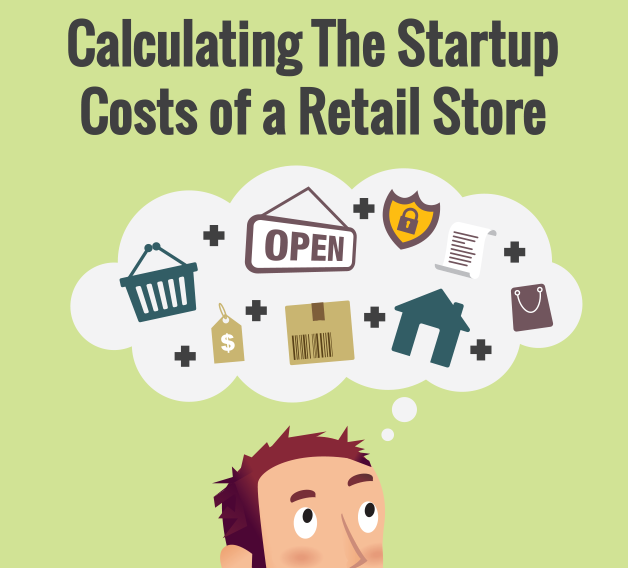The idea of starting your own retail storefront may seem daunting, especially when you start crunching numbers that involve rent, utilities, marketing, inventory and everything else associated with starting up. With so many figures to keep in mind, how do you calculate the overall startup costs? What are the things you need to take into consideration? Below is an easy-to-reference list of the most common startup costs associated with opening a retail store.
Operating costs include anything related to securing a physical location for your business or any recurring costs related to running your business. These will include:
- Rent and security deposits.
- Utilities deposits.
- Utility bills (water, gas, electricity, internet, phone, etc.).
- Liability insurance.
- Association fees and directory listing costs: Your local Chamber of Commerce probably publishes a listing of area businesses that you’ll want to be included in.
- Business license fees.
- Office and cleaning supplies.
- Software subscription fees.
- Credit card merchant account fees.
Rent amounts will vary depending on where you live and where your desired retail space is located. Finding commercial real estate that meets your needs can be a difficult task, so be sure to work with a licensed agent who has experience with retail space in your area.
Software subscriptions refer to computer programs you will use in the course of your business that usually have a monthly or annual cost. Popular examples of subscription software include QuickBooks and the Adobe Creative Suite. QuickBooks is a popular choice for accounting, and the Creative Suite gives you access to programs like Photoshop and Illustrator for a monthly fee. If you plan on playing music in your retail space, consider using an internet streaming music service like Pandora or Spotify.
Your retail store will also need a merchant account to process transactions made using credit cards and other formats, a service that usually carries a monthly and/or per-transaction charge. This account shouldn’t be confused with point-of-service or inventory software, which are usually sold at a fixed price.
Even if your space is retail ready, you will probably need to spend some time tailoring the interior to fit your business. If you plan to make alterations to a retail space, get permission first. After you receive permission, set aside money for:
- Construction costs to customize the space.
- Plumbing installations (including faucets, toilets, towel dispensers, etc.).
- Fixtures, display cases and other items to showcase your products.
- Handyman costs and fees.
These costs will be dependent on your area, as well as how much work the space needs. Ask other local business owners or your commercial real estate agent if he or she can recommend a contractor or construction company that is familiar with this type of work. You can also investigate doing the work yourself; however, the time and labor commitment may be too much for you or your family. For purchasing fixtures and display cases, check for business closings in your area or online classifieds sites if you’re looking to minimize these costs.
Since not all retail stores are created equal, here are some improvements that might be store-specific. Feel free to leave them blank:
- Sound system (for most retailers, especially music stores).
- Fitting rooms/stalls (for clothing retailers).
- Refrigeration units (if your retail location will sell sodas or snacks).
- Break-room installations (if applicable).
Don’t forget to check the terms of your lease, as your landlord might have assumed responsibility for replacing fixtures or fixing electrical or plumbing issues. If your landlord agreed to make alterations before you move in, get it in writing to avoid any issues in the future.
Inventory is probably the most variable cost. It will take a bit of planning and forecasting to make sure you open with enough inventory but not so much that you end up losing money in the first few months of operating. Before you even begin your location search, take some time to find local or regional distributors for the products you intend to stock. Compare prices between them, and don’t hesitate to haggle on per-item pricing, especially if you’re buying in bulk.
To help you get an idea of how much stock you’ll need to order, visit your competitors to see what quantities they have on hand. This should give you a starting number to work with, which you can then use to help determine your distribution expenses.
For a retailer, IT costs will likely be limited to equipment costs and the services needed to use them. While products like phones, computers and printers are sold at fixed prices, your phone and internet bills will be recurring expenses. As always, remember to shop around for the best price for both your equipment and your service plans:
- Computers, printers and phones.
- IT consultant and tech support.
- Telecom services, such as high-speed wireless internet and phone service.
- Website design, maintenance, domain registration, website hosting and development.
- Specialized point-of-service and inventory software.
Launching your business will require quite a bit of promotion, including marketing, advertising and public relations. No matter how large or small your retail business will be, it’s never too early to think about what strategies you will use to promote your store. In the short term, however, consider the costs associated with:
- Your grand opening (including food, beverages, entertainment, door prizes and signage, if applicable).
- Advertising and PR coverage for the grand opening.
- These costs will vary greatly depending on the type of advertising you do. It will also depend on the type of advertising you feel will be most effective for your business and location.
By spending some time planning and preparing for the opening of your business, you can accurately calculate your startup costs to make sure you are well-positioned to address any needs as they arise. For more help with startup budgeting, check out our article on being financially prepared to start a business.





